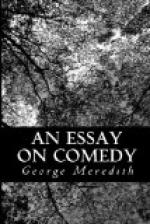Byron had splendid powers of humour, and the most poetic satire that we have example of, fusing at times to hard irony. He had no strong comic sense, or he would not have taken an anti-social position, which is directly opposed to the Comic; and in his philosophy, judged by philosophers, he is a comic figure, by reason of this deficiency. ’So bald er philosophirt ist er ein Kind,’ Goethe says of him. Carlyle sees him in this comic light, treats him in the humorous manner.
The Satirist is a moral agent, often a social scavenger, working on a storage of bile.
The Ironeist is one thing or another, according to his caprice. Irony is the humour of satire; it may be savage as in Swift, with a moral object, or sedate, as in Gibbon, with a malicious. The foppish irony fretting to be seen, and the irony which leers, that you shall not mistake its intention, are failures in satiric effort pretending to the treasures of ambiguity.
The Humourist of mean order is a refreshing laugher, giving tone to the feelings and sometimes allowing the feelings to be too much for him. But the humourist of high has an embrace of contrasts beyond the scope of the Comic poet.
Heart and mind laugh out at Don Quixote, and still you brood on him. The juxtaposition of the knight and squire is a Comic conception, the opposition of their natures most humorous. They are as different as the two hemispheres in the time of Columbus, yet they touch and are bound in one by laughter. The knight’s great aims and constant mishaps, his chivalrous valiancy exercised on absurd objects, his good sense along the highroad of the craziest of expeditions; the compassion he plucks out of derision, and the admirable figure he preserves while stalking through the frantically grotesque and burlesque assailing him, are in the loftiest moods of humour, fusing the Tragic sentiment with the Comic narrative.
The stroke of the great humourist is world-wide, with lights of Tragedy in his laughter.
Taking a living great, though not creative, humourist to guide our description: the skull of Yorick is in his hands in our seasons of festival; he sees visions of primitive man capering preposterously under the gorgeous robes of ceremonial. Our souls must be on fire when we wear solemnity, if we would not press upon his shrewdest nerve. Finite and infinite flash from one to the other with him, lending him a two-edged thought that peeps out of his peacefullest lines by fits, like the lantern of the fire-watcher at windows, going the rounds at night. The comportment and performances of men in society are to him, by the vivid comparison with their mortality, more grotesque than respectable. But ask yourself, Is he always to be relied on for justness? He will fly straight as the emissary eagle back to Jove at the true Hero. He will also make as determined a swift descent upon the man of his wilful choice, whom we cannot distinguish




